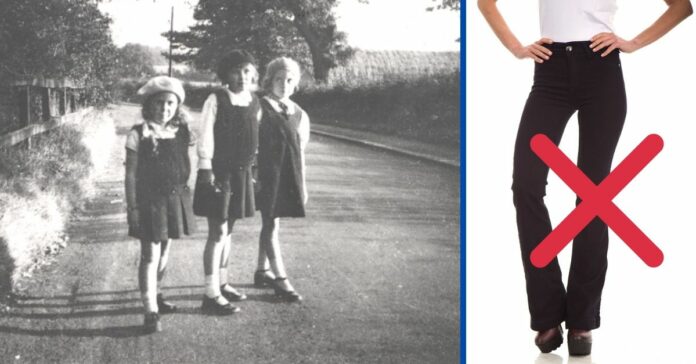The historical restriction on women wearing pants is an intriguing examination of gender norms and societal expectations. This article delves into the multifaceted reasons that have perpetuated the notion that pants are inherently masculine and thus not suitable for women. The denial of this basic clothing choice reflects broader ideologies concerning femininity, morality, and social roles. It invites us to challenge our understanding of these vestiges from the past.
As we explore this subject, it is vital to understand the intersection of religion, culture, and evolving societal norms that have shaped perceptions of women’s clothing choices. By navigating through these complexities, we foster a nuanced appreciation of women’s struggles against sartorial constraints throughout history.
Historical Context: The Fabric of Gender Identity
The origins of women being prohibited from wearing pants can be traced back to ancient civilizations where societal roles were rigidly defined. In many cultures, clothing served as a symbol of status, gender, and conformity. The dichotomy of male and female apparel promoted specific expectations about behavior and dignity, reinforcing the notion that women should embody delicacy and submission.
In ancient Greece, for instance, women typically wore flowing garments known as chitons, while men donned the more practical chiton with a himation or cloak capable of mobility and action. This sartorial division not only reflected the work and home roles males and females undertook, but it also established an early precedent for gendered clothing. Furthermore, certain religious texts became misinterpreted to sanction the differentiation of attire, leading to long-standing conventions that denoted femininity through modest, often restricting garments.
The Crusades and their aftermath marked a significant juncture where women began to participate more visibly in public life, yet clothing remained a battleground of identity and control. Although their roles shifted, the consistent theme was the preservation of societal order through prescribed dress codes, ultimately relegating women to a position where pants symbolized a challenge to established norms.
Morality and Modesty: The Societal Fabric
As the Middle Ages transitioned into the Renaissance, the intersection of morality and women’s attire became increasingly pronounced. With the rise of religious orthodoxy, the imposition of moral codes dictated that women’s garments reflected modesty and purity. The adoption of pants was largely perceived as a transgression against these ideals. Women who sought to embrace more functional or ‘male’ attire were often stigmatized, labeled as immodest or unruly. The persistent societal narrative tied femininity to dependency and fragility, painting pants as a symbol of rebellion.
The Victorian Era epitomized this conflict with a strict moral code exacerbated by rapid social changes. In a period defined by industrial progress and shifting family structures, middle and upper-class women found themselves ensnared by ideals of domesticity and propriety. Corsets and voluminous skirts became the hallmarks of femininity that restricted mobility and reinforced the expectation of women as caretakers rather than participants in public life.
As women pursued education and employment opportunities, the impracticality of traditional female attire came into stark focus. Yet, while some women began to demand more functional clothing, societal surveillance remained high, with many fearing moral degradation as women abandoned conventional skirts for trousers. Thus, a dress code bathed in the ideals of chastity and passivity effectively stifled individual choice. The movement for women’s rights during this time was met with backlash, particularly in terms of attire, as a form of dissent against the prevailing moral order.
Challenging the Norm: The Fight for Functional Fashion
In the late 19th and early 20th centuries, the suffragette movement ignited debates about women’s rights and self-determination, extending into the realm of clothing. Individual women began to challenge the hegemonic standards of femininity by adopting pants for practical reasons. Figures such as Amelia Bloomer popularized a reform dress (the “Bloomers”) that included short skirts over pants, stirring controversy and sparking discussions about modesty, functionality, and identity.
However, the backlash from traditionalists was significant. The act of wearing pants was often equated with a rejection of femininity, which further alienated women who sought to assert their rights through sartorial freedom. Compliance with societal norms thus became a double-edged sword, presenting women with a complex decision between comfort and acceptance.
The world wars were catalyzing events that accelerated change. With men enlisting and leaving vacancies in the workforce, women donned trousers for practical purposes, marking a subtle yet profound shift in societal norms. While Paula T. Smith famously remarked that World War II precipitated the end of the “ladylike” dress code, this transformation was not without resistance. Critics continued to argue that the act of wearing pants undermined the very essence of womanhood.
Repercussions and the Legacy of Feminist Thought
Post-war, the gradual acceptance of women wearing pants reflected broader societal changes, but it was not devoid of controversy. The pantsuit, championed by notable figures in the 1960s and 1970s, became a symbol of women’s liberation movements. Nonetheless, it frequently encountered resistance, as the act of wearing trousers was still associated with a departure from traditional values of femininity.
The liberation of women from sartorial constraints parallels broader discussions surrounding autonomy and identity. When women began to embrace pants not merely as a fashion statement but as an emblem of empowerment, the landscape of gender identity evolved. Yet, the struggle continued as societal expectations and judgments regarding appropriate attire remained entrenched, often dictating how women are perceived and treated in professional environments.
The historical constraints on women’s clothing choices reveal the intersectionality of gender, culture, and societal expectation. Pants were more than just fabric; they embodied a profound struggle for autonomy and self-identity. Today, as women continue to reclaim clothing as a medium of expression, the legacy of past restrictions prompts reflection on the ongoing fight for equality in all realms of life. The question now beckons: how do modern women navigate the expectations of appearance while embracing their authentic selves within a societal framework that often resists change?





























